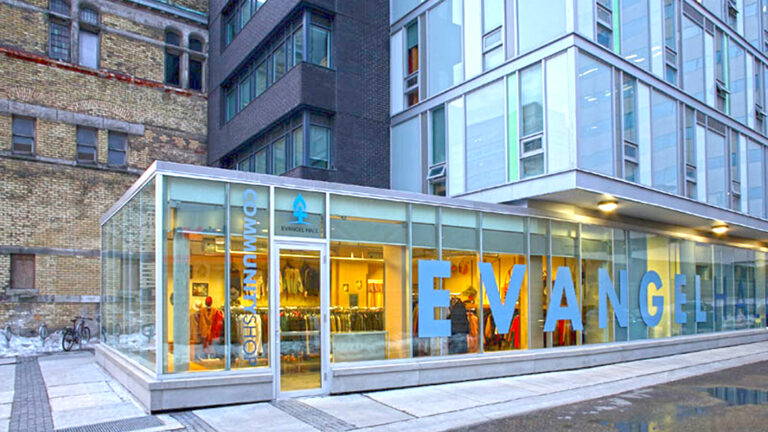For many Canadians, the struggle for affordable housing is just one of many hurdles they face in life. Problems like alcohol or drug dependence, physical or psychological impairment or a wide range of other psycho-social barriers can make social housing solutions a Band-aid at best. Supportive housing improves the odds of long-term success by helping residents overcome problems that contribute to a precarious lifestyle. In Toronto, and with the Centre’s financial backing, several organizations have joined forces to strengthen the sector
“I’ve been here six years. It’s the place where I sobered up,” Ramona, a resident at the Bell Hotel, told the Winnipeg Free Press in December. “Well, at least, most of the time I’ve been sober,” she says in an article spotlighting the transition of the former “flophouse” to a supportive housing facility. “These people are really helpful. I owe them my life.”
Ramona struggles with substance abuse and schizophrenia. Throughout her life, she has experienced long bouts of homelessness. And although Ramona’s story is unique, it is but a grain of sand in the arid supportive housing landscape.
The Bell Hotel is a supported-living community operated by Main Street Project, a non-profit homeless shelter. It uses Housing First, a recovery-oriented approach to homelessness with an emphasis on support services, to help residents adapt and reintegrate into society.
As the Homeless Hub website highlights, “Housing is not contingent upon readiness, or on ‘compliance’ (for instance, sobriety). Rather, it is a rights-based intervention rooted in the philosophy that all people deserve housing, and that adequate housing is a precondition for recovery.”
Healing at home
Supportive housing—whether transitional or permanent—is a pragmatic solution that helps some of the most vulnerable people in society start, and remain, on the path toward recovery while reducing the overall cost of care. It encompasses a range of approaches including housing projects or programs providing rent subsidies and supportive services through home visits. Similarly, supports vary in intensity based on people’s unique needs and may include counselling, case management, income support and assistance and/or life-skills training.
“Supportive housing is sometimes the only solution that can ensure a permanent roof for the most vulnerable people of our community,” observes Luc Labelle, program manager at the Community Housing Transformation Centre. “Mental health issues can isolate a person in many ways and cause them to lose their home. Having dedicated services for them and staff who are trained to face situations complicated by mental health issues makes a huge difference in the way a person can feel at home and secure.”
Perhaps more importantly, supportive housing allows people to live, and heal, in the community. And the evidence is in: A broad body of research demonstrates that supportive housing is a long-term solution for people experiencing mental health issues, substance abuse and chronic homelessness. One study recorded a housing-retention rate of 84.2% over a 3-year period, while the rate for a comparison program was only 59.6% over a shorter 2-year period.
Yet, according to the Canadian Mental Health Association, there are only 10,000 supportive housing units in all of Ontario, with more than 14,000 people on the Access Point waitlist in Toronto only. Recognizing there is an urgent need for supportive housing in Toronto, several organizations collaborated on the Toronto Supportive Housing Growth Plan, which centres on the belief that homelessness should be rare, brief, and non-recurring.
A serious shot at change
“There are approximately 10,000 people experiencing homelessness in Toronto on any given day and thousands on the waiting list for supportive housing,” laments Gautam Mukherjee, executive director at Mainstay Housing, Toronto’s largest non-profit housing agency. “At the same time, we have created very little new supportive housing in Toronto that is owned by non-profit organizations over the last 20 years.”
The Growth Plan—co-led by the Toronto branch of the Canadian Mental Health Association, the Wellesley Institute and the Toronto Alliance to End Homelessness—aspires to help the sector identify shared strategies to meet supportive housing needs in Toronto, with a particular focus on innovative partnerships and approaches to pooling assets that would unlock untapped development potential in the sector.
“A large group of supportive housing organizations have come together to create a Supportive Housing Growth Plan for Toronto, and we have established a target to create 18,000 supportive housing units over 10 years. The city has [endorsed] the same target,” explains Mukherjee.
To build on the Growth Plan, Mainstay Housing submitted a grant application to support the Creation of a Resource Centre to Increase Development Capacity in Toronto’s Supportive Housing Sector. With the help of a $300,000 grant from the Centre, the goal of the Resource Centre is to become a permanent organization offering long-term support. It will help the sector identify shared strategies, provide the tools and guidance to help build on untapped development potential, to explore strategic asset pooling, and to build long-term development capacity.
It’s an exciting development and, according to Mukherjee, “the Centre’s grant will help us organize ourselves and combine our resources in order to create the capacity needed to meaningfully address the urgent need for supportive housing in Toronto.”
The Growth Plan aims to increase the supply of supportive housing in Toronto by:
- Quantifying what assets currently exist (physical stock, land and land values, and rent supplements) and how these could be leveraged to creating new supply;
- Developing a detailed understanding of need, including both the range and type of housing and supports required;
- Understanding how existing government funding could be applied in more strategic ways;
- Rallying the sector around identified needs, priorities, and strategies;
“When we talk about the number of homeless individuals or the waitlist, we often think in terms of putting a roof over their head or ‘housing’ them,” notes Centre deputy executive director Lisa Ker, who worked in the sector for much of her career. “But a home is a place where someone has housing and supports, the essential elements that will help them keep that roof over their heads.
“That is the difference between ‘housing’ people who are experiencing homelessness and providing them with a home, from which they can begin to heal, recover and flourish.”



